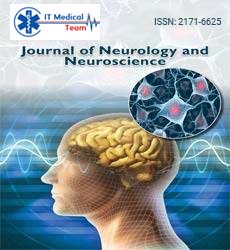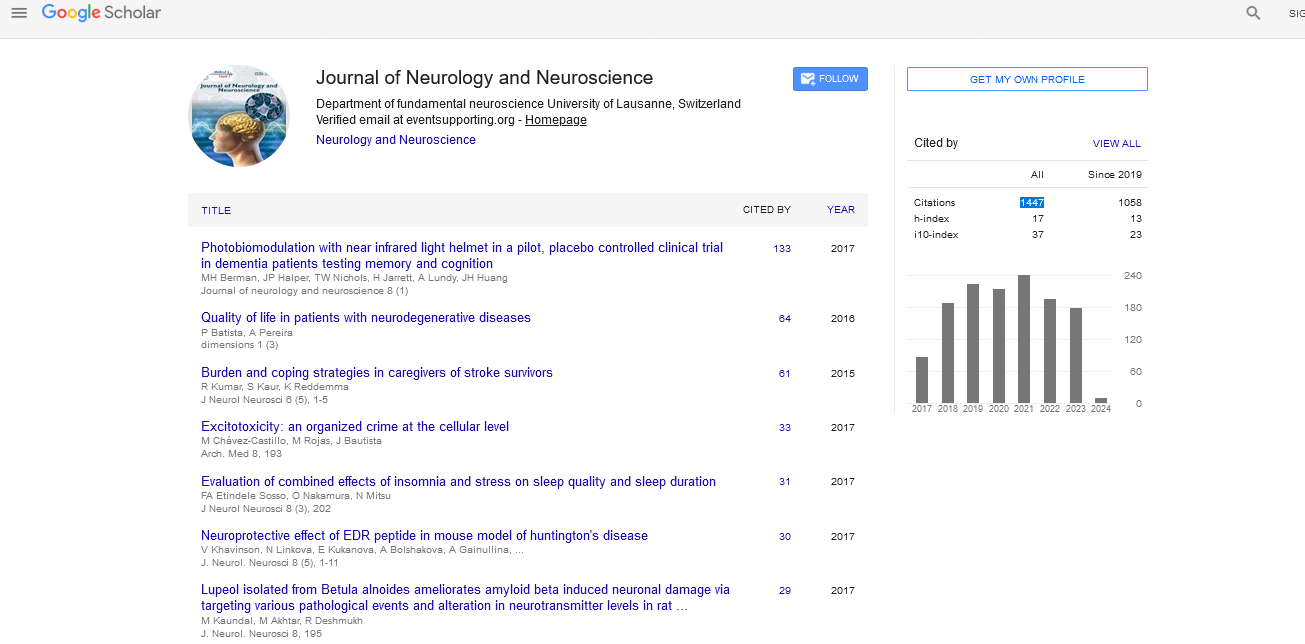Perspective - (2024) Volume 15, Issue 5
Critical periods in neural development implications for learning and behavior
Christos Tsitsipanis*
Department of General Surgery, University Hospital of Heraklion, University of Crete, 71003 Heraklion, Crete, Greece
*Correspondence:
Christos Tsitsipanis, Department of General Surgery, University Hospital of Heraklion, University of Crete, 71003 Heraklion, Crete,
Greece,
Email:
Received: 03-Oct-2024, Manuscript No. ipjnn-24-15387;
Editor assigned: 05-Oct-2024, Pre QC No. P-15387;
Reviewed: 18-Oct-2024, QC No. Q-15387;
Revised: 24-Oct-2024, Manuscript No. R-15387;
Published:
31-Oct-2024
Introduction
The human brain is a remarkably adaptive organ,
undergoing substantial transformations from prenatal
development through adulthood. Among these
transformations, critical periods-specific windows of time
during which the brain is particularly receptive to certain
types of environmental stimuli-play a pivotal role in shaping
neural architecture, learning capacities, and behavior. An
understanding critical period in neural development not
only deepens our comprehension of typical cognitive
processes but also sheds light on developmental disorders
and educational strategies. Critical periods are defined as
distinct time frames in development during which the brain
exhibits heightened plasticity-its ability to reorganize and
adapt in response to experience. During critical periods,
certain stimuli can have profound effects on neural circuitry,
leading to lasting changes in behavior and cognition. If the
appropriate stimuli are not experienced during the critical
period, the opportunity for optimal development may be
lost, leading to potential deficits. Different types of learning
or skills may have distinct critical periods. For instance,
language acquisition occurs most easily in early childhood,
while vision develops during specific stages of infancy [1].
Critical periods are driven by complex neurobiological
processes, including synaptogenesis (the formation of
synapses), synaptic pruning (the elimination of excess
synapses), and the maturation of inhibitory and excitatory
neurotransmitter systems. These processes are influenced
by genetic factors as well as environmental inputs. Early
in life, the brain produces an excess of synapses. This
overproduction allows for greater flexibility, facilitating
learning and adaptation to the environment. As the brain
matures, it undergoes synaptic pruning, where unnecessary
or unused synapses are eliminated. This process is crucial for
refining neural circuits based on experiences and enhancing
overall cognitive efficiency. The balance between excitatory
(glutamate) and inhibitory (GABA) neurotransmitter
systems is critical during critical periods. For example,
a shift from a primarily excitatory environment to one
that includes inhibition can signal the closure of a
critical period [2].
One of the well-studied critical periods is that of
language acquisition. Research shows that children are
especially adept at learning languages between the ages
of 0 to 7 years. During this time, their brains are primed
to decode phonetic nuances and grammatical structures, facilitating bilingualism and native-like proficiency. Studies
using functional imaging reveal increased activation in
specific brain areas, such as Broca's and Wernicke's areas,
during language-related tasks in young children compared
to adults. This indicates that the neural networks involved
in language processing are more malleable during early
childhood. Consequences of Delayed Exposure: Children
who are not exposed to language during this critical
period may experience significant difficulties in language
acquisition later in life. Cases of children raised in extreme
isolation, such as feral children, illustrate the long-lasting
effects of missed opportunities for language exposure [3].
Description
Visual perception is another domain that exhibits
critical periods. The development of binocular vision, for
example, is critically dependent on visual experiences in
the first few years of life. Conditions such as amblyopia,
or "lazy eye," demonstrate the consequences of disrupted
visual input during critical periods. If one eye is deprived
of visual stimulation, the neural pathways associated with
that eye may not develop properly, leading to long-term
vision problems. Remarkably, research has shown that
interventions, such as corrective lenses or patching, can
sometimes restore vision even in cases diagnosed later,
highlighting the brain's ongoing plasticity, although the
results are generally less effective than interventions applied
during the critical period. The development of social skills
and emotional regulation also has critical periods. Early
childhood, particularly the first three years of life, is crucial
for forming attachments and learning social cues [4].
Attachment Theory is attachment theory emphasizes the
importance of early relationships, particularly with primary
caregivers, in shaping emotional and social development.
Secure attachments during infancy are associated with
better emotional regulation and social skills later in life.
Impact of Adversity: Children who experience neglect or
abuse during these formative years may exhibit difficulties
in emotional regulation, increased anxiety, and problems in
social interactions. The neural circuits associated with stress
response and attachment can be adversely affected, leading
to long-term behavioral issues [5].
Understanding critical periods have profound
implications for educational practices and interventions.
Educators can design curricula that align with the critical
periods of development, enhancing learning outcomes.
For instance: Introducing foreign languages in early
childhood can leverage the brain's heightened receptivity,
promoting bilingualism and enhanced cognitive flexibility.
Visual Arts and Music: Exposure to music and arts during
critical periods can foster creativity and improve spatialtemporal
skills. Programs that incorporate these elements
can capitalize on the brain's plasticity during early
development.
Screening Programs: Implementing early screening for
language and social skills can help identify children in need
of support. Programs that offer targeted interventions can
significantly improve outcomes. Educating parents about
the importance of engaging with their children through
language, play, and social interaction during critical periods
can foster healthy development. Understanding critical
periods emphasize the importance of providing resources
and support to at-risk populations. Children in adverse
environments, such as those from low socioeconomic
backgrounds or those experiencing trauma, may require
additional support to maximize their developmental
potential. Initiatives that provide educational support
and resources to families can enhance early childhood
experiences, promoting better developmental outcomes.
Community-based programs that offer early childhood
education, mental health resources, and social services can
mitigate the impacts of adverse experiences during critical
periods.
While significant progress has been made in
understanding the timing and impact of critical periods,
much remains to be explored regarding the underlying
mechanisms. Molecular and Genetic Influences:
Identifying specific genes and molecular pathways that
regulate the onset and closure of critical periods can
provide insights into individual differences in susceptibility
to environmental influences. Understanding how these
factors interact with experience may lead to targeted
interventions. Employing advanced neuroimaging
techniques can help visualize changes in brain structure and
function during critical periods. Longitudinal studies that
track individual development over time can illuminate how
specific experiences shape neural pathways. Investigating
how various environmental factors, such as socioeconomic
status, stress, and nutrition, interact with critical periods
will provide a more comprehensive understanding of
developmental outcomes. Research could explore how
these factors modify brain plasticity and critical period
timing.
Conclusion
Critical periods in neural development are essential to
understanding how experiences shape learning and behavior.
By recognizing these windows of heightened plasticity, we
can inform educational practices, early interventions, and
policies aimed at supporting healthy development. The
implications of this knowledge extend beyond individual
learning outcomes; they highlight the necessity for societal
commitment to nurturing environments that foster
optimal development for all children, particularly those at
risk. As research continues to unravel the complexities of
critical periods, it will undoubtedly guide future strategies
in education, healthcare, and social services, ensuring that
every child has the opportunity to thrive.
References
- Vigil FA, de Fátima Oliveira-Silva I, Ferreira LF, et al. Spatial memory deficits and thalamic serotonergic metabolite change in thiamine deficient rats. Behav Brain Res. 2010; 210(1):140-142.
Google Scholar, Crossref, Indexed at
- Pavlenko A. Affective processing in bilingual speakers: Disembodied cognition?. Int J Psychol 2012; 47(6):405-428.
Google Scholar, Crossref, Indexed at
- Nunes PT, Gómez-Mendoza DP, Rezende CP, et al. Thalamic proteome changes and behavioral impairments in thiamine-deficient rats. Neuroscience. 2018; 10:385:181-197.
Google Scholar, Crossref, Indexed at
- Błaszczyk J. Nigrostriatal interaction in the aging brain: new therapeutic target for Parkinson’s disease. Acta Neurobiol Experiment. 2017; 77(1):106-112.
Google Scholar, Crossref, Indexed at
- Chen ZR, Huang JB, Yang SL, Hong FF. Role of cholinergic signaling in Alzheimer’s disease. Molecules. 2022; 27(6):1816.
Google Scholar, Crossref, Indexed at





